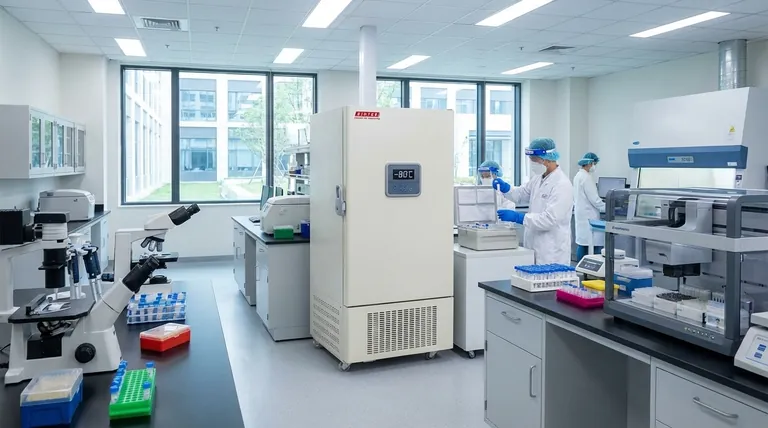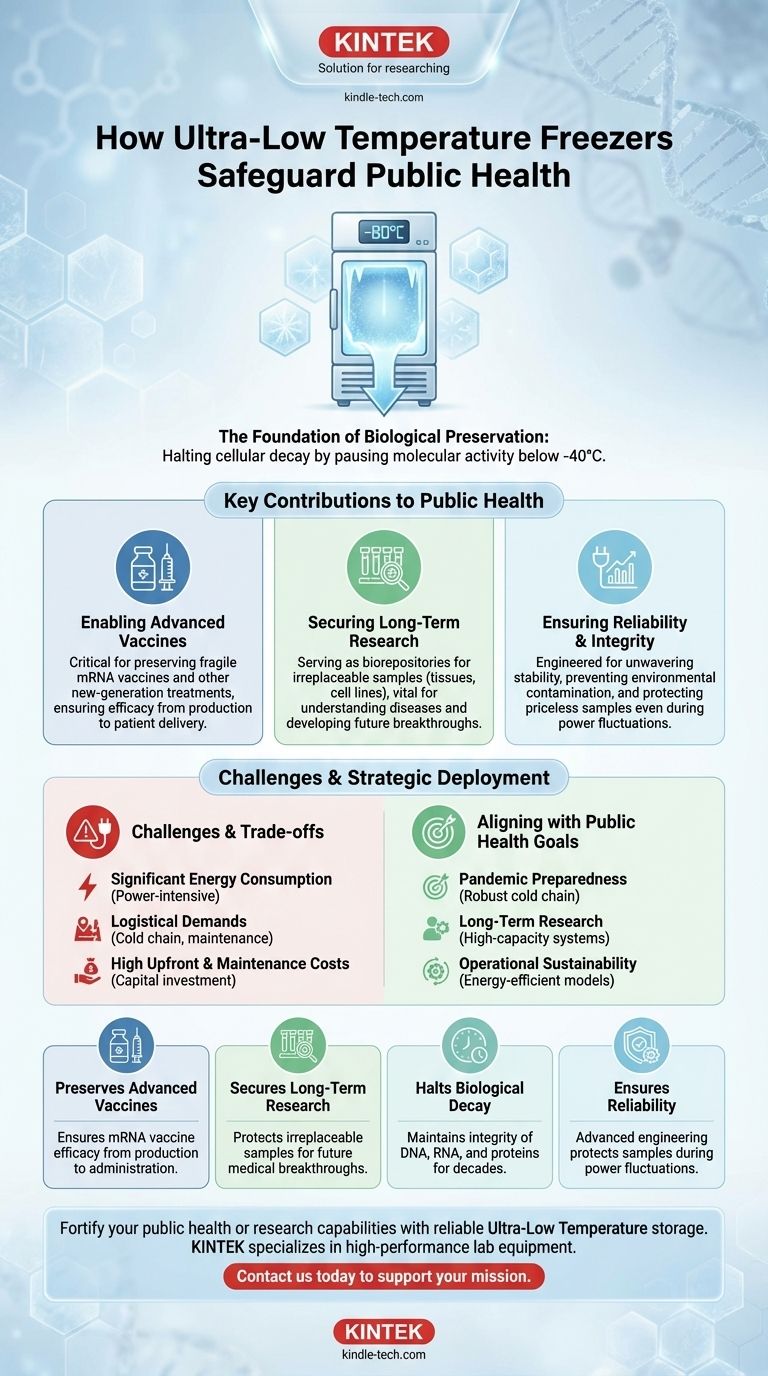At its core, an Ultra-Low Temperature (ULT) freezer is a cornerstone of modern public health infrastructure. It provides the highly stable, deep-freezing environment required to preserve the viability of critical biological materials, including advanced vaccines, patient tissues for research, and other irreplaceable microbiological samples.
The true contribution of ULT freezers isn't just about keeping things cold; it's about guaranteeing the integrity of the biological assets that underpin medical research, pandemic response, and long-term scientific study.

The Foundation of Biological Preservation
The need for temperatures below -40°C goes beyond simple refrigeration. At these extreme lows, virtually all biological activity ceases, preventing the degradation that would otherwise destroy sensitive molecular structures.
Halting Cellular Decay
For materials like DNA, RNA, and delicate proteins, standard freezing isn't enough. ULT freezers push temperatures so low that they effectively pause time on a molecular level, preserving samples in a state of suspended animation for years or even decades.
Enabling Advanced Vaccines
The global response to the COVID-19 pandemic highlighted the importance of ULT freezers. New-generation mRNA vaccines are notoriously fragile and require stable, ultra-low temperatures to maintain their efficacy from the manufacturing plant to the patient's arm.
Securing Long-Term Research Assets
Scientific and medical breakthroughs depend on the long-term study of biological samples. ULT freezers serve as "bio-banks," reliably storing tissues, cell lines, and other specimens that are essential for understanding diseases and developing future treatments.
The Engineering Behind Reliability
A public health instrument must be dependable above all else. The design of a modern ULT freezer focuses on maintaining a precise environment, even when external conditions are unpredictable.
Unwavering Temperature Stability
These units are engineered for minimal temperature fluctuation. Many feature advanced recovery systems that can rapidly bring the temperature back to its set point after a door opening or even during a power failure, protecting thousands of priceless samples.
Preventing Environmental Contamination
The integrity of a sample is paramount. Features like multi-point silicon gaskets create an airtight seal that prevents warmer, humid air from entering the chamber, which is critical for avoiding ice build-up and potential contamination.
Optimizing the Laboratory Environment
Modern ULT units are also designed for operational efficiency. Compared to older equipment, they often consume significantly less energy, emit less heat into the workspace, and operate at much lower noise levels, creating a more sustainable and productive research environment.
Understanding the Challenges and Trade-offs
While indispensable, the deployment of ULT technology is not without its complexities. Acknowledging these challenges is key to effective public health planning.
Significant Energy Consumption
Even energy-efficient models are power-intensive pieces of equipment. The energy required to maintain temperatures of -80°C represents a significant operational cost and environmental footprint for any institution.
Logistical and Infrastructure Demands
Establishing a reliable "cold chain" with ULT freezers is a major logistical hurdle. It requires stable electricity, trained personnel for maintenance, and careful planning, particularly for deployment in remote or under-resourced regions.
High Upfront and Maintenance Costs
ULT freezers are a major capital investment. Beyond the initial purchase price, they require specialized maintenance and monitoring to ensure they continue to function within precise specifications, protecting the value of the materials stored inside.
Aligning Technology with Public Health Goals
The strategic use of ULT freezers depends entirely on the specific objective at hand.
- If your primary focus is pandemic preparedness: The priority is building a robust and decentralized cold chain to ensure next-generation vaccines can be distributed and administered effectively.
- If your primary focus is long-term medical research: The goal is to invest in reliable, high-capacity ULT systems to create secure biorepositories that will fuel scientific discovery for decades.
- If your primary focus is operational sustainability: The key is to evaluate and adopt newer, energy-efficient models that reduce operating costs and environmental impact without compromising sample integrity.
Ultimately, the ultra-low temperature freezer is a critical tool that safeguards the very biological materials that protect and advance human health.
Summary Table:
| Key Contribution | Benefit to Public Health |
|---|---|
| Preserves Advanced Vaccines | Ensures mRNA vaccine efficacy from production to administration. |
| Secures Long-Term Research | Protects irreplaceable samples for future medical breakthroughs. |
| Halts Biological Decay | Maintains integrity of DNA, RNA, and proteins for decades. |
| Ensures Reliability | Advanced engineering protects samples during power fluctuations. |
Ready to fortify your public health or research capabilities with reliable Ultra-Low Temperature storage? KINTEK specializes in providing high-performance lab equipment, including ULT freezers, to meet the critical needs of laboratories, research institutions, and public health organizations. Our solutions ensure the integrity of your most valuable biological materials. Contact us today to discuss how we can support your mission.
Visual Guide

Related Products
- 58L Precision Laboratory Ultra Low Temperature Upright Freezer for Critical Sample Storage
- 408L Advanced Vertical Laboratory Ultra Low Temperature Freezer for Critical Research Material Preservation
- 708L Ultra Low Temperature Freezer High Performance Laboratory Freezer
- 208L Advanced Precision Laboratory Ultra Low Temperature Freezer for Cold Storage
- 608L Essential Laboratory Ultra Low Temperature Freezer For Critical Sample Preservation
People Also Ask
- What are ultra low temperature freezers used for? Preserving Critical Biological Samples for Decades
- What are ultralow temperature freezers and what are they used for? Preserve Critical Samples for Decades
- What temperature range do Ultra-Low Temperature freezers maintain? The -80°C Standard for Sample Integrity
- What is ultra-low temperature freezing and what is its primary purpose? Preserve Biological Samples for Years
- What temperature range do Ultra-Low Temperature (ULT) freezers typically maintain? Preserve Your Samples from -40°C to -86°C



















